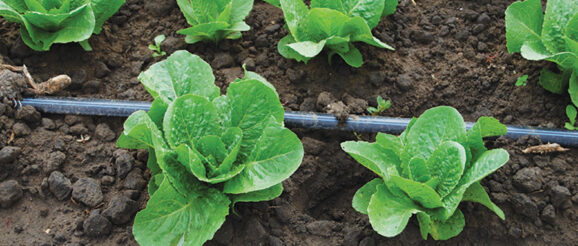Water conservation thrives on technology and innovation

 Building trust in food begins with empowering farmers through one of the largest and most diverse conservation- and sustainability-focused public-private partnerships in our nation’s history: America’s Conservation Ag Movement. To find the latest news and resources related to the Movement, visit AgWeb.com/ACAM.
Building trust in food begins with empowering farmers through one of the largest and most diverse conservation- and sustainability-focused public-private partnerships in our nation’s history: America’s Conservation Ag Movement. To find the latest news and resources related to the Movement, visit AgWeb.com/ACAM.
Trees that water themselves, soil that pulls moisture from the air and various probes, sensors and automated irrigation systems are some of the innovations on the drawing board or already in use to help the agriculture industry in its quest to conserve water.
Estimates of how much water is used for agriculture vary, but the Organization for Economic Co-operation and Development, which has about three dozen member countries, including the U.S., estimates that agriculture irrigation accounts for 70% of water use worldwide.
Emilio Tenuta, senior vice president and chief sustainability officer at St. Paul, Minn.-based Ecolab, stressed the importance of water conservation at the first Sustainable Produce Summit, produced by The Farm Journal, in October.
“Water stress is not a future issue,” he said. “It is happening now, in all parts of the world.”
The world faces a 56% water deficit by 2030 if no action is taken, he said.
But it appears that action is being taken, at least in the U.S.
Ag industry experts say growers already have made significant progress in implementing technological advances and water-saving techniques, and there’s more to come.
Greensboro, N.C.-based Syngenta U.S. is working on a number of projects designed to conserve water, said Dale Nicol, AgriEdge manager for Syngenta’s Western Commercial Unit, Wasco, Calif.
The company has come up with Agrisure Artesian corn hybrids that are drought tolerant and perform well in a variety of soil types and climates, he said.
But the cornerstone of AgriEdge is farm record-keeping software.
“With that tool, a grower is capable of tracking all of the inputs and the variable and fixed costs that go into producing a crop, including water,” Nicol said.
Phytech, an Israel-based company that is part of the Syngenta Ventures portfolio, can measure the micro expansions and contractions of the trunks of almond trees with a dendrometer.
Ken Shackel, professor/pomologist at the University of California, Davis, is analyzing Phytech’s sensor as well as a sensor from Davis-based FloraPulse Co. developed by Cornell University, and one from Israel-based Saturas.
All are designed to measure water stress in trees, which can indicate when a tree needs water.
The next step is to develop software and hardware that will allow a tree to start and stop the irrigation system, Shackel said.
At the University of Texas at Austin, engineers have developed soil that can pull water from the air and distribute it to plants, said Guihua Yu, associate professor of materials science in the Walker Department of Mechanical Engineering.
The university’s atmospheric water irrigation system uses super-moisture-absorbent gels to extract water out of the air at night.
Solar heat during the day activates the water-containing gels to release their contents into the soil.
The concept might be available to farmers within a few years, Yu said.
Danny Merkley, director of water resources for the California Farm Bureau Federation, prefers the term “water use efficiency” to water conservation.
“You do not necessarily conserve water per se, but you are using it more efficiently, and you’re more productive with it,” he said.
Some growers use micro sprinklers that emit a fine spray that puts out a precise amount of water, he said.
And they’re adding return flow systems that capture runoff at the end of a field and move it back for irrigation.
Drip irrigation has taken off throughout the country and can double yields using the same amount of water as surface irrigation, Merkley said.
With drip irrigation, water is “going straight to the plant, where it needs it,” he said, not saturating the soil profile.
Mike Helle, owner and president of Green Gold Farms, Edinburg, Texas, has been farming for 35 years and switched to drip irrigation in 2000.
He started using drip irrigation on watermelons and saved so much water that he switched to drip for onions and other vegetables as well.
Before the changeover, Helle was using the flood irrigation method.
“I am saving over 60% in water use versus flood irrigation,” he said.
He uses subsurface Netafim tape and electronic moisture meters in the field.
Drip irrigation is a time and labor saver, he said, and helps increase crop production.
Water conservation programs were launched about 10 years ago in Florida, said Charles Shinn, director of government and community affairs for the Florida Farm Bureau Federation.
But work continues.
“We went from high volume to low volume in the 1980s, but in the last five to eight years, we’ve had advancements in computer technology and soil moisture monitoring,” he said.
Many systems now are automated or enable farmers to use smartphones to make water management decisions on the fly.
“They don’t have to be in the field turning things on or turning things off,” Shinn said.
Some new, high-efficiency irrigation techniques use overhead drag line systems — also called mobile drip systems — so that water goes directly into the soil or on top of the soil over the crop they are irrigating as opposed to broadcasting water and allowing evaporation, said Jay Bragg, associate director of commodity and regulatory activities for the Texas Farm Bureau,
In Texas, the system is used primarily with corn and cotton crops.
Subsurface drip tape is the most efficient way to water high-value produce commodities, such as leafy greens and many others, he said.
For grapefruit and citrus, surface drip and micro-irrigation or microsprayer irrigation systems are used, but many growers still rely on some form of flood irrigation.
For the past serval decades, irrigation districts in the Rio Grande Valley have invested heavily in upgrading and/or lining irrigation canals and ditches, Bragg added.
“This has resulted in a significant amount of water savings.”
There’s a long arc of increased efficiency and development as science and technology evolve and are integrated into agriculture, said Mike Wade, executive director of the California Farm Water Coalition.
Water use is declining and will continue to decline, Wade said.
“I think the future’s bright in terms of water use efficiency for agriculture and urban water users.”
